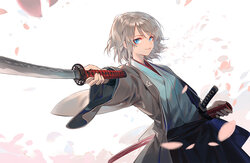Samurai
Moegirlpedia would welcome your assistance in improving this article☆Kira~
As you read this article, you're welcome to participate in editing this page. Before editing, please read the wiki quickstart, editing guidelines and retrieve relevant information. We wish you a good time on Moegirlpedia. |
 | |
| Base Info | |
| Moe Point | Samurai |
|---|---|
| Moe Point Synonyms | Bushi |
| Related Moe Points | katana |
Samurai were a social class in Japan from the 10th to the 19th century, originally a military aristocracy educated in civil and military affairs and responsible for civil administration or fighting in wars. It later evolved to refer to Japanese swordsmen who mastered swordsmanship, and who never leaved without their sword.
It is important to note that not every person who wields a katana is a samurai. Some people may use a katana as a weapon, but aren't samurai and won't call themselves as such.
Contents
Introduction
The precursors of samurai were the military officers who emerged in the Rikugo system in the Heian period of Japan, this system was established by Emperor Kanmu of Japan to consolidate his power. Before the Heian period, it was the obligation of all free men, except slaves, to be recruited by the Emperor.
Yet these officers had to resupply and feed themselves, many people were unable to return to their hometowns because of this, choosing instead to settle in the area. People could be exempted from military services by paying their taxes, and such soldiers, who were mainly composed of peasants, were collectively known as sakimori (防人) in Japan. Because of the irregularity of sakimori and the huge burden it placed on the farmers, it was abolished by Emperor Kanmu. This form of soldier was not a true samurai, in the sense of the word.
In the early Heian period (late 8th-early 9th century), Emperor Kanmu wanted to consolidate and expand his dominion in Northern Honshu Island. The Emperor was concerned about the lack of morale and discipline of the Northern Expeditionary Force sent to Northern Honshu, that made it difficult to win in the battlefield. So Emperor Kanmu decided to ask for help in local families and population, and offered to grant the title of Sei Taishogun (征夷大将軍, せいいたいしょうぐん) to any local power that replaces him in the conquest of Northern Honshu. These powerful families, skilled in bow and arrow and horseriding, soon became the Emperor's tools to support the resistance. To cope with the conquest, the military system no longer became available for all; the samurai system, a fully dedicated service, became popular within Japan.
At the end of the 12th century, samurai Minamoto Yoritomo became the Sei Taishogun, founded the Shogunate and took command of the overall military, marking the dawn of the samurai era. Most of the subsequent military leaders took on the position of Sei Taishogun, and ruled over. From the year 1192 onward, most of the Shogunate forces held actual power in Japan.
In ACGN works
Works that are themed around samurai
Archetypes of historical samurai
- William Adams: An English sailor who later stayed in Japan as a samurai for some reasons.
Fictional samurai